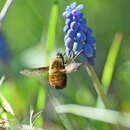Biology
(
anglais
)
fourni par Arkive
Little is known of the life-cycle of this particular species of bee-fly, however it is likely to be similar to that of other members of the genus Bombylius. Gravid females coat their eggs in sand and then flick these at suitable solitary bee nests whilst hovering. The larvae seek out the burrows of their hosts, and develop as parasites on the exterior surface of the host. It is not known where this species pupates (7). The precise hosts of dotted bee-fly larvae are not known, although it is believed that bees of the genus Andrena are likely candidates (2), in particular, the mining bees Andrena flavipes and Andrena cineraria.
Adult bee-flies are 'heralds of spring', emerging during the first warm days of March and April (6). They can be seen hovering around flowers, and are somewhat reminiscent of humming birds (5).
Conservation
(
anglais
)
fourni par Arkive
A number of known populations that support this species are designated Sites of Special Scientific Interest (SSSIs) or National Nature Reserves (NNRs). The dotted bee-fly is a UK Biodiversity Action Plan (UK BAP) priority species, its Species Action Plan aims to maintain all current populations, and make sure that at least 20 viable populations throughout the former range are in place by 2010 (2). Furthermore, English Nature has included this species in its Species Recovery Programme.
Description
(
anglais
)
fourni par Arkive
As the common name suggests, the dotted bee-fly is somewhat similar in appearance to a bee with its stout, furry body (3). Like all flies, it has a single pair of wings for flight; the hind wings have been modified into drumstick-like balancing appendages known as 'halteres' (4). Striking features that allow bee-flies to be distinguished from bees include their long, spindly legs, and the long stiff proboscis, which is held out in front of the head and used to probe flowers for nectar (5). This scarce species is highly distinctive, with brown spots on the wings and black hairs at the end of the abdomen (7).
Habitat
(
anglais
)
fourni par Arkive
As the larvae of the dotted bee-fly are parasites of solitary bees, the species can persist only where there are good host populations, typically open areas, with dry, bare soil where the hosts can nest (6). Suitable sites must also provide sufficient nectar-rich flowers for the adults to feed on (2). Typical sites therefore include unimproved pastureland, cliff edges and old quarries (8).
Range
(
anglais
)
fourni par Arkive
Recorded from many counties of southern England with strongholds in Somerset, Dorset, the Isle of Wight and Kent (8). The species underwent a dramatic decline and contraction of range in the 1960s and 1970s (2) but recently has been shown to be expanding its range northwards (8). Outside of Britain, this bee-fly is widely distributed in Europe (2).
Status
(
anglais
)
fourni par Arkive
Classified as Nationally Scarce in Great Britain (2).
Threats
(
anglais
)
fourni par Arkive
This species declined following the catastrophic crash in populations of solitary bees during the 1960s and 1970s; this was the result of the widespread intensification of agriculture, which reduced the number of suitable nest sites, and the availability of suitable flowers for host bees (2).
Bombylius discolor
(
anglais
)
fourni par wikipedia EN
- licence
- cc-by-sa-3.0
- droit d’auteur
- Wikipedia authors and editors
Bombylius discolor: Brief Summary
(
anglais
)
fourni par wikipedia EN
Bombylius discolor is a Palearctic species of fly in the family Bombyliidae.
- licence
- cc-by-sa-3.0
- droit d’auteur
- Wikipedia authors and editors

